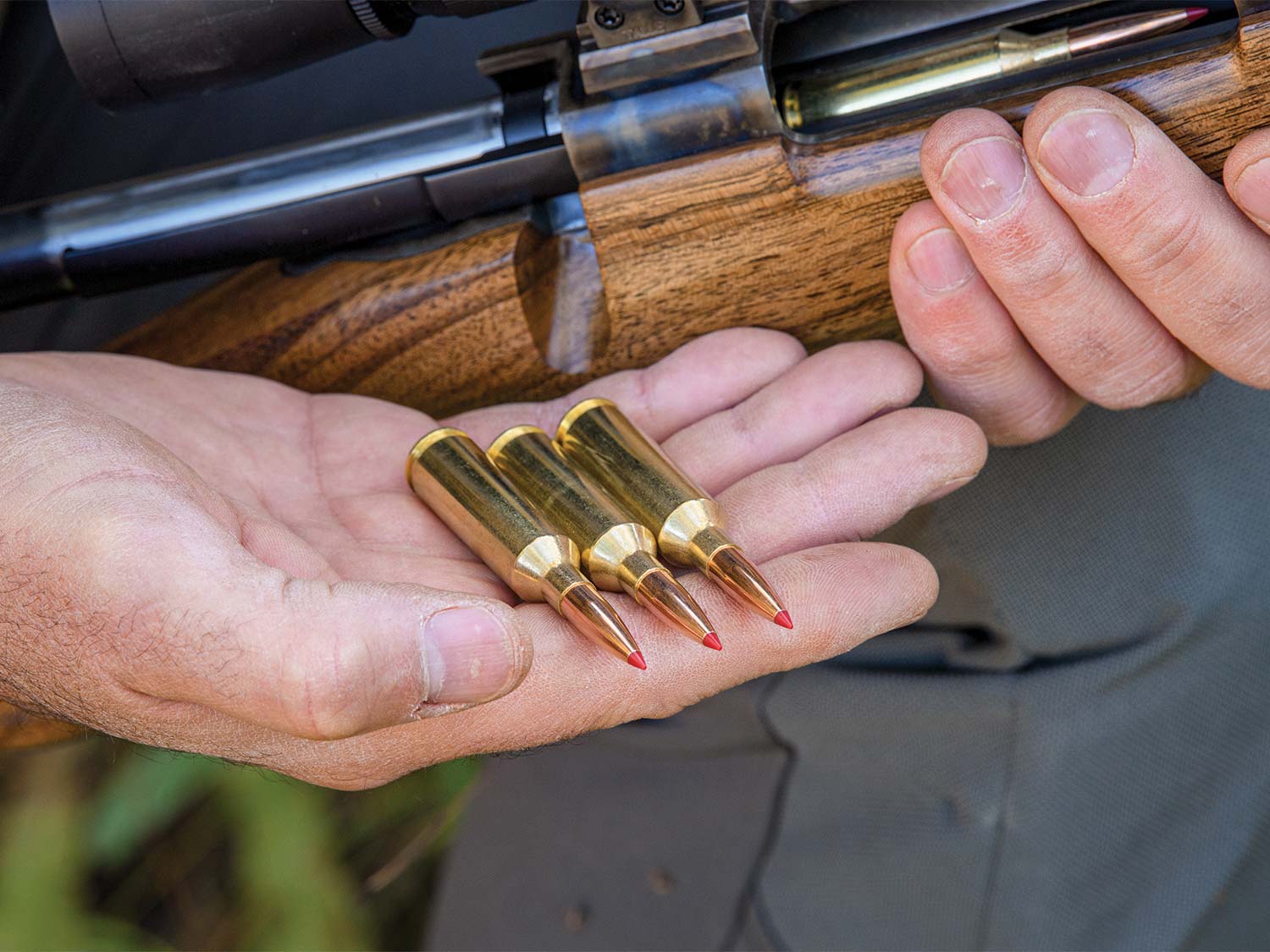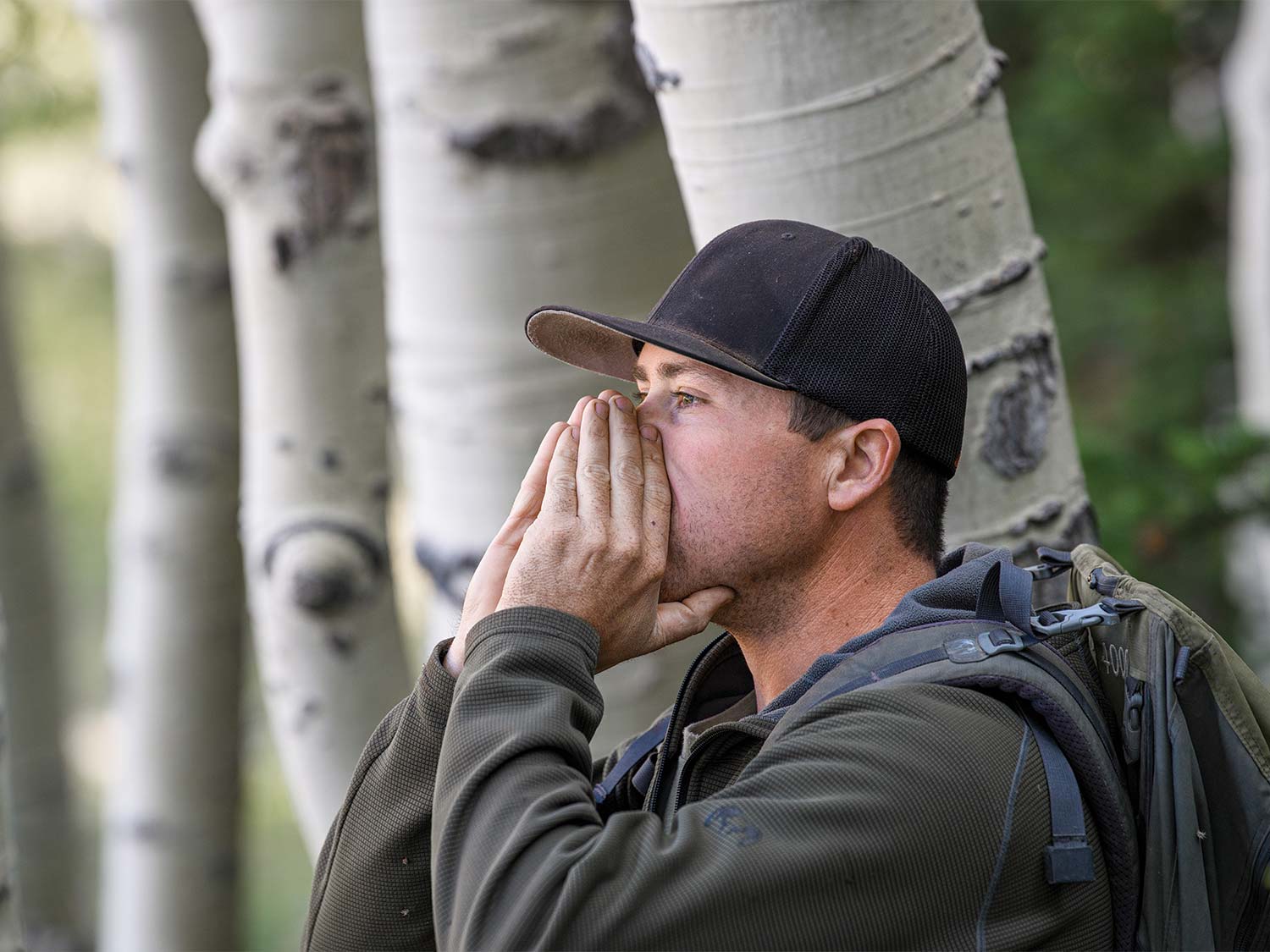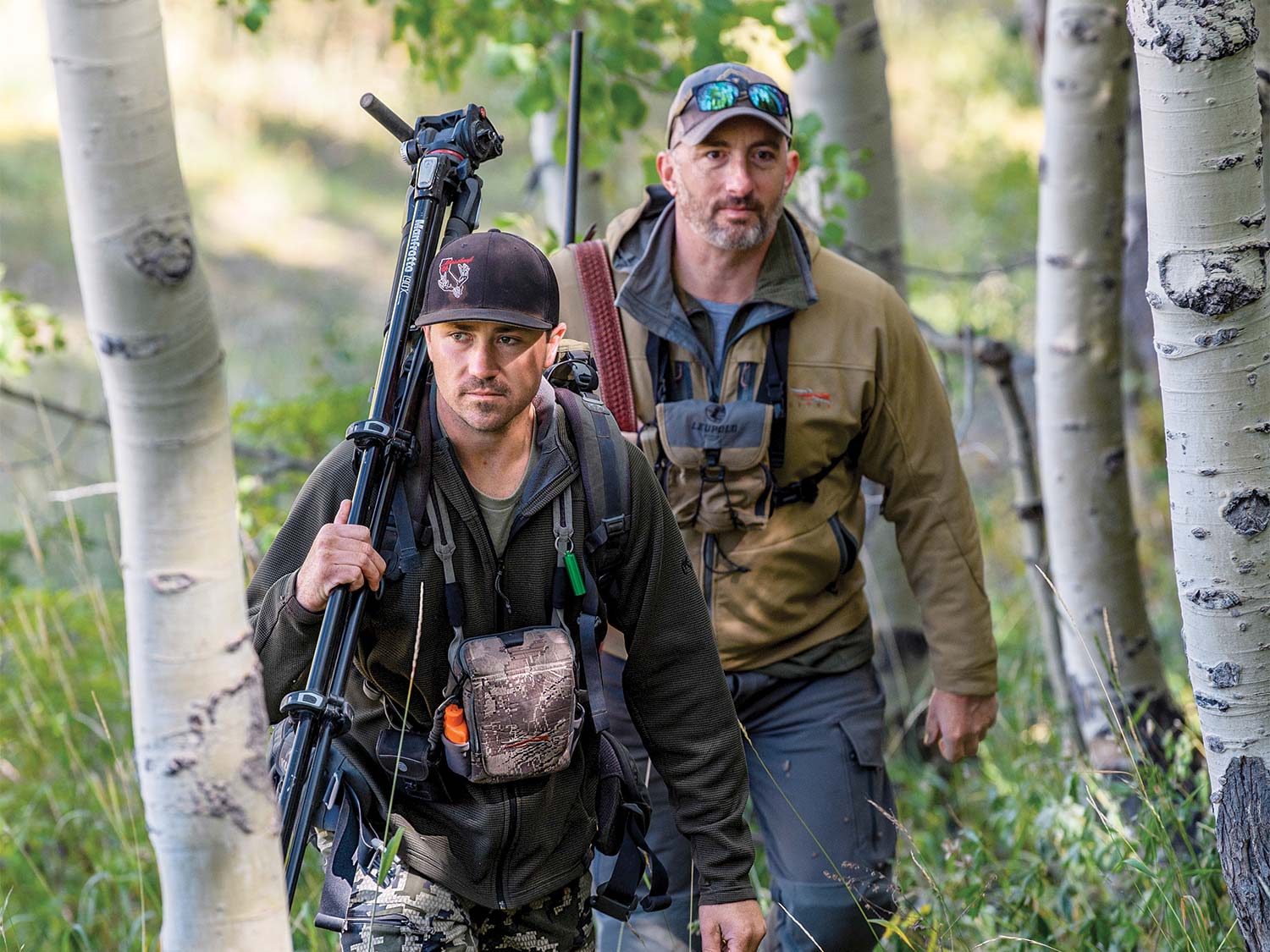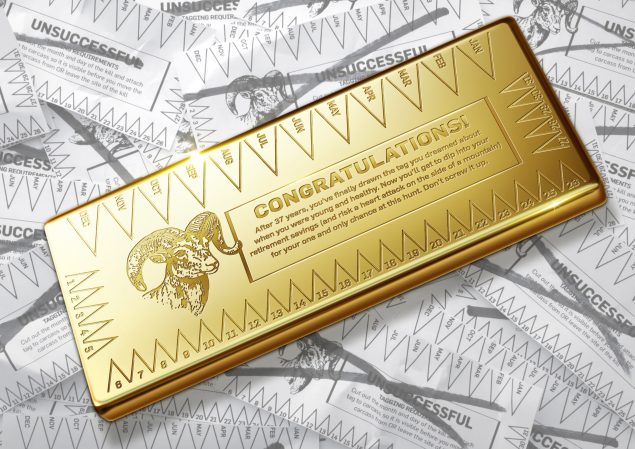I was standing in a long line that snaked through a maze formed by Tensabarrier stanchions, those portable stands with retractable webbing used by the TSA, concert stadiums, motor vehicle departments, and other venues that want to funnel large groups of people in an orderly fashion.
I glanced at the sheet of paper in my hand, a form with dozens of check boxes with my personal information filled in at the top. It was the size of a menu at a 24-hour Greek diner.
Everyone in the crowd around me, mostly men and most wearing something decorated with camo, held identical applications. I didn’t need to be a mind reader to know their thoughts: Maybe this year.
We were in a broad, carpeted hallway in the Salt Palace Convention Center in Salt Lake City, where the Western Hunting & Conservation Expo takes place every February, usually right around Valentine’s Day.
On the form, 200 Utah tags were in play, everything from humble public-land turkey permits to once-in-a-lifetime opportunities like bison and desert sheep. For the modest fee of $5 per tag, you could try your luck for as many of them as you qualified for. (Some are specifically for nonresidents only.)
The fact that you had to apply for the tags in person at the expo turned what’s normally a solitary ritual into a social event, not unlike a hunter’s Mardi Gras, but with no beads, less skin (thankfully), and (sadly, per Utah’s regulations) weaker beer.

Once I got to the head of the line, I coughed up the money for an annual Utah hunting license ($65 for nonresidents) and another couple hundred dollars for the tags I had selected, my hopes focused on the big five: the individual nonresident tags set aside for bighorn sheep, desert sheep, Shiras moose, mountain goats, and wild bison.
My relatively modest contribution to the expo’s coffers would be used for conservation efforts throughout the state, mostly to benefit mule deer. (The Mule Deer Foundation and Sportsmen for Fish and Wildlife cosponsor the Expo.) These projects include the removal of invasive piñon-juniper woodlands to increase forage and restore rangelands, aspen regeneration, research on mule deer migration corridors, the installation of wildlife-friendly fencing, and more.
All told, the sales from those 200 tags raised $1.1 million for conservation. That’s serious money, but it wasn’t the biggest revenue generator at the show. A series of auctions where high-dollar hunts, custom rifles, and even diamond rings are put up for bid bring in more than $3 million each year, most of which is rolled into conservation efforts around the West.
The expo provides a good snapshot of how state game agencies are trying to maintain funding for critical wildlife projects and research in a world where participation in hunting is dropping and revenue generated by license sales—for generations the cornerstone of funding for wildlife and game and fish departments—is falling off.
Like a carrot hanging from a stick in front of a mule, marquee trophy tags are dangled before hunters to motivate them to open their wallets for conservation. States have learned to leverage the scarcity of these hunting opportunities to generate millions of dollars in funds.

Broadly speaking, hunters have two ways to snatch the carrot: digging deep into their pockets and purchasing a hunt at auction or playing the odds—the very long odds—via various lotteries and drawings, most of which are governed by Byzantine point systems that require the applicants (particularly nonresidents) to pony up substantial sums of money, much of it nonrefundable, to participate.
For tens of thousands of hunters, myself included, the only way we’ll ever get to hunt a bighorn sheep or mountain goat in the Lower 48 is via the second route.
So, every year, we put in for those dream tags and hope against hope that our name is picked. At the expo, more than 3,400 other nonresidents put in for each of the top hunts. That put the odds of drawing an individual tag at .0294 percent. It’s dismal by any measure. And yet five lucky stiffs were going to score.
Last year, one of those lucky stiffs was me.
Pay to Play
Phone calls, texts, emails, and Facebook messages flooded in before I knew what had happened. The results of the 200-tag draw are watched more intently than the predawn sky of the waterfowl opener. Most were friends congratulating (and cursing) me for winning the lone nonresident Shiras moose tag. But several messages were from guides and outfitters hoping to secure a client.
It’s no secret that Western hunting is big business. Hell, I’ve been with Outdoor Life since 2001, and have worked as a writer and editor in the outdoor industry for 25 years, so I’ve been enmeshed in the business side of the outdoors for most of my adult life. Even so, the mercantile tone of these communications caught me off guard.

I was sent pictures and video clips of specific moose that I was assured had survived the previous season, along with quotes for the cost to hunt them. Though these animals were very much wild, this dynamic had the flavor of high-fence deer operations, where a person (I wouldn’t use the term hunter) cuts a hefty check to kill a captive whitetail. Perhaps I had been naive, but this wasn’t something I’d associated with any type of Western hunting I’d ever do. This was the realm of the ultra-affluent, who employ squadrons of scouts and spotters to target specific animals—a practice that has prompted much criticism itself over the years.
But this did bring to the fore an important question confronting me. My tag was for the Wasatch Range in Utah—a unit that covers about 10 percent of the state. Living more than six hours away, I knew that my ability to meaningfully scout and hunt it on my own was minimal.
I was going to need help.
I’ve hunted moose enough over the years, both on my own and on guided hunts, to know that they are tricky creatures. They are difficult to pattern, lead largely solitary lives, favor thick cover, and can traverse huge swaths of ground from one day to the next.
These facts, coupled with my distance from the hunting grounds, prompted me to seek out a guide.

I ended up connecting with Doyle Moss, owner of Mossback Guides & Outfitters, a Utah-based operation that specializes in guiding high-end hunts. Moss and the guides who work for him have developed a reputation for their intimate knowledge of Western hunting and putting their clients on impressive animals. This success has also made them a lightning rod for hunters who feel the commercialization of Western hunting, which they say gives the well-heeled sportsman an unfair advantage over the average Joe, has gone too far.
Moss chalks up this attitude to sour grapes. “When an average person draws a tag, how much help do they get from friends and family? Some of them will have 7 to 15 people on their team,” he says. “The giants we kill are on public land, and our clients have one or two, sometimes three, people working for them.”
Moss gave me a good deal on the hunt. For a few thousand dollars, I’d have six days of hunting with a guide and a spotter. We settled on dates in early October, but I was keeping the four-week season, which kicked off in mid-September, clear just in case Moss’ network of guides happened to locate a nice bull during the first weeks of archery elk season.
Between that and the cost to purchase my bull moose license ($1,518), plus assorted expenses, I quickly bumped against my bank account’s pain threshold.

Away Game
Seven years ago, I drew a resident moose tag in Montana. That was another stroke of good luck, but one in which the odds were much better than was the case for the Utah expo draw. I did that hunt on my own. I spent 21 days in the Little Belt mountains, glassing, calling, and hiking. My biggest concern wasn’t finding a bull. Rather, it was making sure I didn’t end up shooting one more than a mile from a road. Recovering a moose under any circumstances is a hellish ordeal, and that distance was the most I was willing to endure, given that I didn’t have horses or mules to help.
During a few of those forays, I took my kids and bird dog along. I had a 20-gauge with me and would shoot grouse and make us tailgate fajitas. I sipped black coffee, and Ava and Jack drank hot cocoa. We slept on foldout cots alongside the truck, and brushed the snow and frost from the sleeping bags in the morning before exiting our warm cocoons to start another day hunting the vast woods and mountains of the Lewis and Clark National Forest.
I never did find the bull of my dreams, but with no regrets I filled that tag with a cow and was able to get her cut up, packed out, and loaded into the back of my pickup with the help of my friend Mark, who came out with me that final weekend.
I knew from the get-go that my Utah hunt would be different.

In early October, I got a call from Jonnie Kellogg, one of Moss’ guides. He was down in Heber City, about 40 miles south and east of Salt Lake City, on the other side of the Wasatch Range.
“How soon can you get down here?” he said. “I’ve got a couple bulls spotted.”
I’d been ready for that summons for weeks. My rifle, a beautiful Dakota 6.5 PRC, was zeroed (see story, p. 15), and my hunting gear was prepacked in duffels. I made a quick supply run for food and beer, and checked in with my buddy Bill Buckley, who was coming along to photograph the adventure.
We tossed our bags and coolers into the truck, pointed our noses south, and drove the eight hours from Bozeman to the dirt-road coordinates Kellogg had texted me.
One and Done
I hit it off with Jonnie right away. He was young, eager, and amped up to kill a bull. His Toyota Tacoma was in full hunting-bum mode, gear scattered around the cab and empty white Monster cans on the floorboards.
As Bill and I changed into our hunting clothes, Jonnie filled us in. He and our spotter, Colton Harness, had been watching three different bulls in the area, one of which was locked down with a cow a few miles away. They had seen this bull early in the day on a timbered ridge higher up in the mountains. The rut had been in full swing, so the chances were good that the bull would hang tight until he was done breeding the cow.
We convoyed up the dirt road, gaining altitude with each switchback, to a lookout where Colton was posted up behind a spotting scope.

It was late afternoon, and the angled rays of the sun illuminated swaths of mountain maples that were in full crimson foliage. The aspens were pale green, with some leaves showing the first glimpses of yellow, and some of the scrub oak had started to turn, but otherwise the trees around us had yet to take on fall colors.
We glassed the pines where Colton and Jonnie had last seen the bull, a north-facing ridge of timber about 1,200 yards from our perch.
It wasn’t five minutes before a patch of black hide detached itself from the thick cover. The cow moved across a small opening, followed soon by the bull, his bright antlers gleaming in contrast to the dark surroundings.
“Let’s get him!” Jonnie said.
I appreciated his enthusiasm, but I wanted to hit pause for a moment.
We had six days to hunt and were barely six minutes into the adventure. I asked for more details about the other bulls Jonnie and Colton had seen. Jonnie told me one was smaller than the bull we were glassing, and that they hadn’t seen the other bull in a few days. “Was the other bull bigger than this one?” I asked. Yeah, it was, Jonnie told me, but going after it wasn’t really an option. When pressed, he explained that another man had purchased a moose tag for his son and had spent a princely sum for Mossback guides and scouts to keep an eye on it—about $25,000 all told.
“Even if we could find that bull, I’d be fired if I let you kill it,” he said.
This was a Friday afternoon in the middle of hunting season and we were on public land within an hour’s drive of Salt Lake City. And having a good bull in our glass that was accessible with slim prospects for finding a better animal made the decision easy.
We set off. The bull was out of sight during the stalk, but there was no reason to think he’d go far. We just needed to move quickly before the light failed.
We climbed a ridge covered in scrub oak that was across from where we’d last seen the bull. We found an open area that gave us a commanding view of the dark timber where the bull and his cow had hunkered down.
It took about 15 minutes of glassing before I spotted a leg with my binocular. After that, we managed to make out more of the animal, though we couldn’t tell whether it was the cow or the bull.
I prepped for the shot and waited, but the animals weren’t moving out of the cover.
Jonnie started calling, cupping his hands around his mouth and making the deep muwah sound of a rival bull looking for love.
Our boy didn’t like that one bit. He peeled off from the cow and started grunting back, walking stiff-legged in our direction, rocking his head from side to side as he approached.
I’m pretty sure Jonnie could have called the bull across the draw and into our laps, but I decided to take the shot before the moose disappeared into the creekbottom.
I worked the bolt on the Dakota as fast as I could, putting three rounds into the bull in a matter of seconds. He stood for a moment, stunned, and then his legs gave out and he tumbled from view.
The luck that allowed me to score this tag in the first place held as we climbed from our perch to find the bull. Not only had he piled up in a relatively open clearing, but we were able to pack him out along a game trail by the creekbottom to a spot about 400 yards away, where we were able to get our trucks—all downhill.

We worked in the dark, cutting and loading meat into game bags and ferrying them to the vehicles. A little after midnight, we were back in Heber City, celebrating at a cheap Mexican restaurant. We wolfed down plates of carne asada, chorizo tacos, and breakfast burritos as exposed fluorescent lights hummed overhead.
The next morning, we went back into the hills. It was Saturday, and it seemed that half of Utah had decided to join us. Families in Jeeps and trucks festooned with light bars, winches, and gleaming chrome caravanned around. ATV riders kicked up clouds of dust along any stretch where they could redline their engines. Hunters in blaze-orange dotted the landscape. (Curiously, Utah exempts moose, sheep, and some other big-game hunts from this requirement.)
Through my binocular, I watched a trio of hunters hike the ridge where we had shot the bull the evening prior. I doubt they had a moose tag, but the bull and cow certainly wouldn’t have stayed put with people stomping through their bedroom.
That trip to Utah lasted less than 24 hours, my once-in-a-lifetime tag filled in a flash. I spent the next week processing meat, wrapping it in plastic wrap and butcher paper for the freezer.
How do I take the measure of such an experience? Calculated on cost per minute, it was an expensive proposition. And unlike every other moose hunt I’d been on, it could hardly be called a wilderness adventure.
And yet, I can still see that bull grunting and full of fight, rocking his head from side to side, ready to defend his cow from an interloper, a wild and fierce animal that demanded, and still commands, my respect.
At the expo this past February, I handed over the menu-size form to a smiling lady, wrote a check for several hundred dollars, and couldn’t help but think: Maybe this year. Again.
























